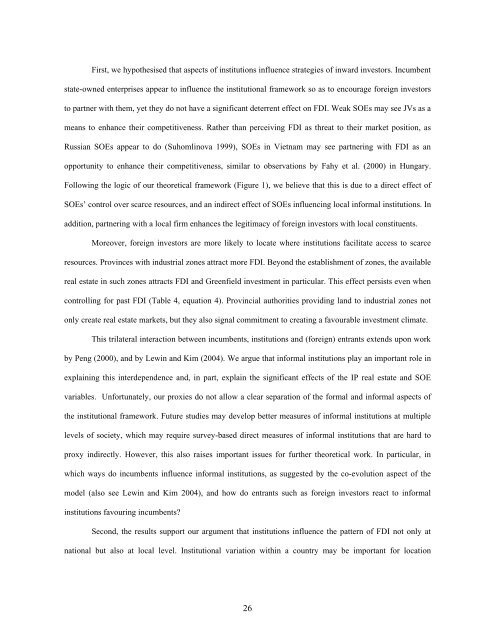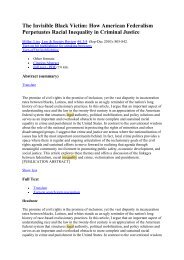Foreign Investment Strategies and Sub-national ... - E-Journal
Foreign Investment Strategies and Sub-national ... - E-Journal
Foreign Investment Strategies and Sub-national ... - E-Journal
Create successful ePaper yourself
Turn your PDF publications into a flip-book with our unique Google optimized e-Paper software.
First, we hypothesised that aspects of institutions influence strategies of inward investors. Incumbent<br />
state-owned enterprises appear to influence the institutional framework so as to encourage foreign investors<br />
to partner with them, yet they do not have a significant deterrent effect on FDI. Weak SOEs may see JVs as a<br />
means to enhance their competitiveness. Rather than perceiving FDI as threat to their market position, as<br />
Russian SOEs appear to do (Suhomlinova 1999), SOEs in Vietnam may see partnering with FDI as an<br />
opportunity to enhance their competitiveness, similar to observations by Fahy et al. (2000) in Hungary.<br />
Following the logic of our theoretical framework (Figure 1), we believe that this is due to a direct effect of<br />
SOEs’ control over scarce resources, <strong>and</strong> an indirect effect of SOEs influencing local informal institutions. In<br />
addition, partnering with a local firm enhances the legitimacy of foreign investors with local constituents.<br />
Moreover, foreign investors are more likely to locate where institutions facilitate access to scarce<br />
resources. Provinces with industrial zones attract more FDI. Beyond the establishment of zones, the available<br />
real estate in such zones attracts FDI <strong>and</strong> Greenfield investment in particular. This effect persists even when<br />
controlling for past FDI (Table 4, equation 4). Provincial authorities providing l<strong>and</strong> to industrial zones not<br />
only create real estate markets, but they also signal commitment to creating a favourable investment climate.<br />
This trilateral interaction between incumbents, institutions <strong>and</strong> (foreign) entrants extends upon work<br />
by Peng (2000), <strong>and</strong> by Lewin <strong>and</strong> Kim (2004). We argue that informal institutions play an important role in<br />
explaining this interdependence <strong>and</strong>, in part, explain the significant effects of the IP real estate <strong>and</strong> SOE<br />
variables. Unfortunately, our proxies do not allow a clear separation of the formal <strong>and</strong> informal aspects of<br />
the institutional framework. Future studies may develop better measures of informal institutions at multiple<br />
levels of society, which may require survey-based direct measures of informal institutions that are hard to<br />
proxy indirectly. However, this also raises important issues for further theoretical work. In particular, in<br />
which ways do incumbents influence informal institutions, as suggested by the co-evolution aspect of the<br />
model (also see Lewin <strong>and</strong> Kim 2004), <strong>and</strong> how do entrants such as foreign investors react to informal<br />
institutions favouring incumbents?<br />
Second, the results support our argument that institutions influence the pattern of FDI not only at<br />
<strong>national</strong> but also at local level. Institutional variation within a country may be important for location<br />
26














